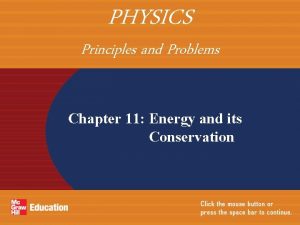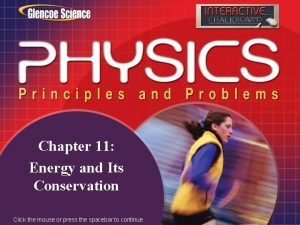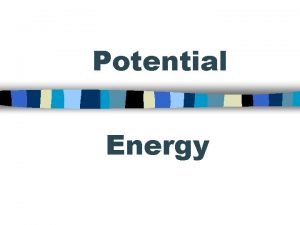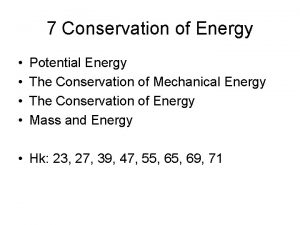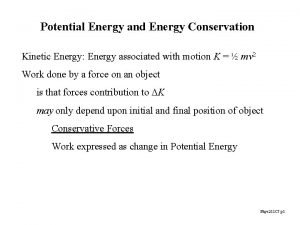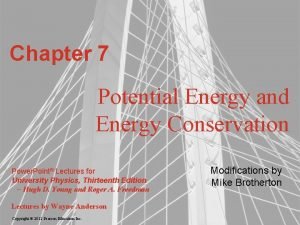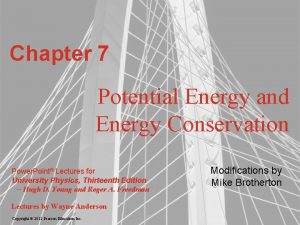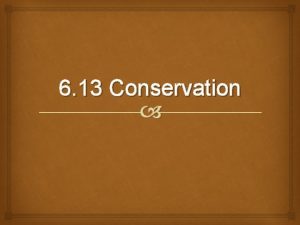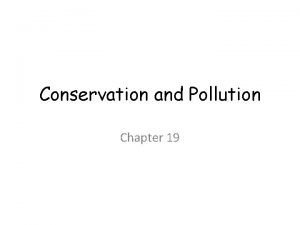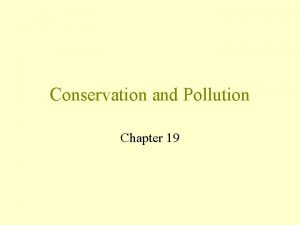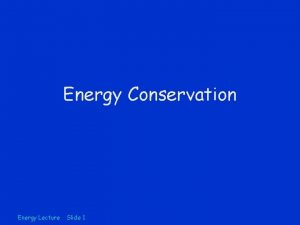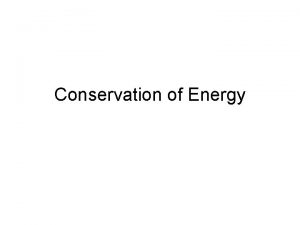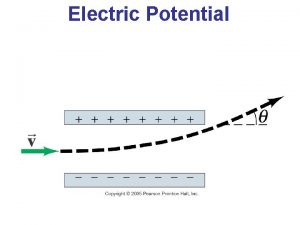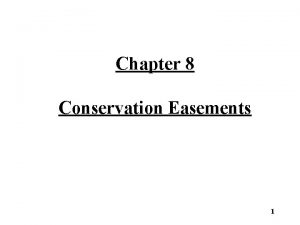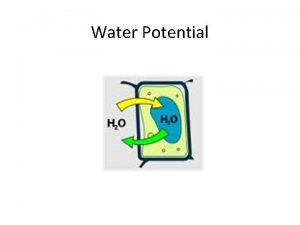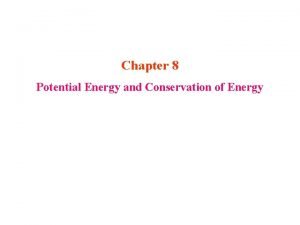Chapter 7 Potential Energy and Energy Conservation Power
























- Slides: 24

Chapter 7 Potential Energy and Energy Conservation Power. Point® Lectures for University Physics, Thirteenth Edition – Hugh D. Young and Roger A. Freedman Lectures by Wayne Anderson Copyright © 2012 Pearson Education Inc. Modifications by Mike Brotherton

Goals for Chapter 7 • To use gravitational potential energy in vertical motion • To use elastic potential energy for a body attached to a spring • To solve problems involving conservative and nonconservative forces • To determine the properties of a conservative force from the corresponding potential-energy function • To use energy diagrams for conservative forces Copyright © 2012 Pearson Education Inc.

Introduction • How do energy concepts apply to the descending duck? • We will see that we can think of energy as being stored and transformed from one form to another. Copyright © 2012 Pearson Education Inc.

Gravitational potential energy • Energy associated with position is called potential energy. • Gravitational potential energy is Ugrav = mgy. • Figure 7. 2 at the right shows how the change in gravitational potential energy is related to the work done by gravity. Copyright © 2012 Pearson Education Inc.

The conservation of mechanical energy • The total mechanical energy of a system is the sum of its kinetic energy and potential energy. • A quantity that always has the same value is called a conserved quantity. • When only the force of gravity does work on a system, the total mechanical energy of that system is conserved. This is an example of the conservation of mechanical energy. Figure 7. 3 below illustrates this principle. Copyright © 2012 Pearson Education Inc.

An example using energy conservation • Refer to Figure 7. 4 below as you follow Example 7. 1. • Notice that the result does not depend on our choice for the origin. Copyright © 2012 Pearson Education Inc.

When forces other than gravity do work • Refer to Problem. Solving Strategy 7. 1. • Follow the solution of Example 7. 2. Copyright © 2012 Pearson Education Inc.

Work and energy along a curved path • We can use the same expression for gravitational potential energy whether the body’s path is curved or straight. Copyright © 2012 Pearson Education Inc.

Energy in projectile motion • Two identical balls leave from the same height with the same speed but at different angles. • Follow Conceptual Example 7. 3 using Figure 7. 8. Copyright © 2012 Pearson Education Inc.

Motion in a vertical circle with no friction • Follow Example 7. 4 using Figure 7. 9. Copyright © 2012 Pearson Education Inc.

Motion in a vertical circle with friction • Revisit the same ramp as in the previous example, but this time with friction. • Follow Example 7. 5 using Figure 7. 10. Copyright © 2012 Pearson Education Inc.

Moving a crate on an inclined plane with friction • Follow Example 7. 6 using Figure 7. 11 to the right. • Notice that mechanical energy was lost due to friction. Copyright © 2012 Pearson Education Inc.

Work done by a spring • Figure 7. 13 below shows how a spring does work on a block as it is stretched and compressed. Copyright © 2012 Pearson Education Inc.

Elastic potential energy • A body is elastic if it returns to its original shape after being deformed. • Elastic potential energy is the energy stored in an elastic body, such as a spring. • The elastic potential energy stored in an ideal spring is Uel = 1/2 kx 2. • Figure 7. 14 at the right shows a graph of the elastic potential energy for an ideal spring. Copyright © 2012 Pearson Education Inc.

Situations with both gravitational and elastic forces • When a situation involves both gravitational and elastic forces, the total potential energy is the sum of the gravitational potential energy and the elastic potential energy: U = Ugrav + Uel. • Figure 7. 15 below illustrates such a situation. Copyright © 2012 Pearson Education Inc.

Motion with elastic potential energy • Follow Example 7. 7 using Figure 7. 16 below. • Follow Example 7. 8. Copyright © 2012 Pearson Education Inc.

A system having two potential energies and friction • In Example 7. 9 gravity, a spring, and friction all act on the elevator. • Follow Example 7. 9 using Figure 7. 17 at the right. Copyright © 2012 Pearson Education Inc.

Conservative and nonconservative forces • A conservative force allows conversion between kinetic and potential energy. Gravity and the spring force are conservative. • The work done between two points by any conservative force a) can be expressed in terms of a potential energy function. b) is reversible. c) is independent of the path between the two points. d) is zero if the starting and ending points are the same. • A force (such as friction) that is not conservative is called a nonconservative force, or a dissipative force. Copyright © 2012 Pearson Education Inc.

Frictional work depends on the path • Follow Example 7. 10, which shows that the work done by friction depends on the path taken. Copyright © 2012 Pearson Education Inc.

Conservation of energy • Nonconservative forces do not store potential energy, but they do change the internal energy of a system. • The law of the conservation of energy means that energy is never created or destroyed; it only changes form. • This law can be expressed as K + Uint = 0. Copyright © 2012 Pearson Education Inc.

Force and potential energy in one dimension • In one dimension, a conservative force can be obtained from its potential energy function using Fx(x) = –d. U(x)/dx • Figure 7. 22 at the right illustrates this point for spring and gravitational forces. Copyright © 2012 Pearson Education Inc.

Force and potential energy in two dimensions • In two dimensions, the components of a conservative force can be obtained from its potential energy function using Fx = – U/dx Copyright © 2012 Pearson Education Inc. and Fy = – U/dy

Energy diagrams • An energy diagram is a graph that shows both the potential-energy function U(x) and the total mechanical energy E. • Figure 7. 23 illustrates the energy diagram for a glider attached to a spring on an air track. Copyright © 2012 Pearson Education Inc.

Force and a graph of its potential-energy function • Figure 7. 24 below helps relate a force to a graph of its corresponding potential-energy function. Copyright © 2012 Pearson Education Inc.
 Electrostatic potential energy
Electrostatic potential energy V = pe/q
V = pe/q Chapter 7 energy conservation of energy
Chapter 7 energy conservation of energy Actual power and potential power
Actual power and potential power Potential energy of an electric field
Potential energy of an electric field Chapter 11 study guide energy and its conservation answers
Chapter 11 study guide energy and its conservation answers Chapter 11 energy and its conservation answers
Chapter 11 energy and its conservation answers Potential enrgy
Potential enrgy Spring potential and kinetic energy
Spring potential and kinetic energy Kinetic energy and potential energy formula
Kinetic energy and potential energy formula Potential energy units
Potential energy units Nerve action potential
Nerve action potential Equipotential lines
Equipotential lines Calculating water potential
Calculating water potential Market potential and forecasting
Market potential and forecasting Electric potential inside non conducting sphere
Electric potential inside non conducting sphere Joules per coulumb
Joules per coulumb Chapter 25 electric potential
Chapter 25 electric potential Power trianlge
Power trianlge Power formula
Power formula Gravitational potential energy formula
Gravitational potential energy formula Potential energy to chemical energy examples
Potential energy to chemical energy examples Sample of mechanical energy
Sample of mechanical energy Gravitational potential energy vs kinetic energy
Gravitational potential energy vs kinetic energy What is kinetic and potential energy
What is kinetic and potential energy





